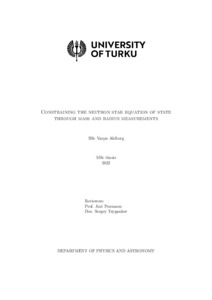Constraining the neutron star equation of state through mass and radius measurements
Ahlberg, Varpu (2022-11-23)
Constraining the neutron star equation of state through mass and radius measurements
Ahlberg, Varpu
(23.11.2022)
Julkaisu on tekijänoikeussäännösten alainen. Teosta voi lukea ja tulostaa henkilökohtaista käyttöä varten. Käyttö kaupallisiin tarkoituksiin on kielletty.
avoin
Julkaisun pysyvä osoite on:
https://urn.fi/URN:NBN:fi-fe2022112967728
https://urn.fi/URN:NBN:fi-fe2022112967728
Tiivistelmä
The equation of state of cold dense matter is not well known. The models for cold dense matter can be constrained through the measurement of neutron stars, as they are the densest directly observable objects in the universe. Their mass-radius relation is determined by their equation of state, making it an important observable. This thesis discusses various methods to measure the masses and radii of neutron stars using X-ray observations. A new model for the optical depth of the accretion funnel of accreting neutron stars is presented.
The thermal emission spectrum of neutron stars can be used for mass-radius measurement. The observed flux depends on the distance and the apparent size of the emitting body. Due to relativistic effects, the apparent size is dependent on both the mass and the radius. The biggest uncertainties in this method lie with the difficulty of measuring distance and the modeling of the emission spectrum itself.
Periodic pulsations in the X-ray flux of neutron stars can be similarly utilized. It is caused by one or more hot spots on the neutron star surface created through some source of uneven heating. The pulse profile is affected by several relativistic effects, which gives its shape a dependence on mass and radius. This method is independent of distance, however it contains multiple difficult to measure parameters such as the geometry of emission.
In accreting neutron stars, the pulse profile is affected by the absorption of light through the accreting plasma. The optical depth is dependent on the direction of emission, causing a dip in brightness when the spot is closest to the observer. The effect can be modeled using simple approximations for the density profile and geometry of the accretion flow. This correction is capable of recreating the secondary minimum seen in certain pulse profiles.
The thermal emission spectrum of neutron stars can be used for mass-radius measurement. The observed flux depends on the distance and the apparent size of the emitting body. Due to relativistic effects, the apparent size is dependent on both the mass and the radius. The biggest uncertainties in this method lie with the difficulty of measuring distance and the modeling of the emission spectrum itself.
Periodic pulsations in the X-ray flux of neutron stars can be similarly utilized. It is caused by one or more hot spots on the neutron star surface created through some source of uneven heating. The pulse profile is affected by several relativistic effects, which gives its shape a dependence on mass and radius. This method is independent of distance, however it contains multiple difficult to measure parameters such as the geometry of emission.
In accreting neutron stars, the pulse profile is affected by the absorption of light through the accreting plasma. The optical depth is dependent on the direction of emission, causing a dip in brightness when the spot is closest to the observer. The effect can be modeled using simple approximations for the density profile and geometry of the accretion flow. This correction is capable of recreating the secondary minimum seen in certain pulse profiles.
